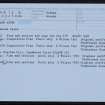Pricing Change
New pricing for orders of material from this site will come into place shortly. Charges for supply of digital images, digitisation on demand, prints and licensing will be altered.
Rousay, Bigland Round
Chambered Cairn (Neolithic), Cremation (Early Neolithic), Scraper (Tool) (Early Neolithic), Unidentified Pottery (Early Neolithic)
Site Name Rousay, Bigland Round
Classification Chambered Cairn (Neolithic), Cremation (Early Neolithic), Scraper (Tool) (Early Neolithic), Unidentified Pottery (Early Neolithic)
Alternative Name(s) Faraclett Head
Canmore ID 2709
Site Number HY43SW 13
NGR HY 4382 3250
Datum OSGB36 - NGR
Permalink http://canmore.org.uk/site/2709
- Council Orkney Islands
- Parish Rousay And Egilsay
- Former Region Orkney Islands Area
- Former District Orkney
- Former County Orkney
HY43SW 13 4383 3250.
(HY 437325) 'Bigland Round Cairn', an Orkney-Cromarty tripartite round cairn is situated on the edge of the lowest of the terraces on the SW face of Faraclett Head, just above the limit of cultivation, and was excavated by W G Grant in 1938. (RCAHMS 1946). It is circular except for a flattening at the SE by the entrance, has diameters of 37 to 40ft, and is surrounded by two wall-faces, the outer of well-laid masonry still standing up to 2ft 6ins high. The inner wall-face is 3-4ft behind and in line with the inner end of the short entrance passage. The passage, 3ft 10 ins long and 1ft 9ins wide, was blocked at the outer end by masonry built flush with the outer- wall-face. The roofless chamber is 15ft 8ins long by 3ft 10ins to wide and aligned NW-SE. It is entered between two portal stones and is divided into three compartments by two pairs of upright slabs. A small hollow dug into the subsoil was found outside the cairn on the S side, 11ft from the entrance and 5ins from the wall- face. It measured 1ft 8ins by 1ft 3ins at surface level, reducing to 11 by 10 ins at the bottom and was 6 1/2 ins deep. It was bottomed by clay and full of black peaty ash. Numerous sherds, a flint scraper and two flint chips from the site are now in the National Museum of Antiquities of Scotland (NMAS).
A S Henshall 1963
A chambered cairn at HY 4383 3250, as described and planned by Henshall.
Surveyed at 1:2500.
Visited by OS(ISS) 18 October 1972.
Scheduled as Bigland, round chambered tomb.
Information from Historic Scotland, scheduling document dated 10 December 2001.
Note (1982)
Bigland, Round (ORK 2) HY 4383 3250 HY43SW 13
Tripartite round cairn. Finds in NMAS.
RCAHMS 1982
(Wilson Portfolio ff. 18 and 21; RCAMS 1946, ii, p. 204, No. 565; Henshall 1963, 183-4; OR 614)
Note (2020)
Bigland Round
This burial site in Orkney Islands was a focus for funerary practices in the Neolithic period, between 4000 BC and 3301 BC.
Prehistoric Grave Goods project site ID: 60080
CANMORE ID: 2709
Total no. graves with grave goods: 1
Total no. people with grave goods: 1
Total no. grave goods: 4
Prehistoric Grave Goods project Grave ID: 74112
Grave type: Pit
Burial type(s): Cremation
Grave good: Pot; Materials used: Pottery; Current museum location: National Museum of Scotland
Grave good: Pot; Materials used: Pottery; Current museum location: National Museum of Scotland
Grave good: Scraper; Materials used: Chert / Flint [Flint]; Current museum location: Unknown
Grave good: Flake; Materials used: Chert / Flint [Flint]; Current museum location: National Museum of Scotland
Further details, the full project database and downloads of project publications can be found here: https://doi.org/10.5284/1052206
An accessible visualisation of the database can be found here: http://blogs.reading.ac.uk/grave-goods/map/
Orkney Smr Note
Visited by RCAMS in 1935 when just a mound with 5 protruding
stones, then excavated 1938 by Walter Grant and details and plan
supplied by him. Fragments of two Neolithic pots were found.
[R1]
Has been stripped, and all constructional features are
exposed. - Detailed description. Classified as Orkney-Cromarty
tripartite round cairn. [R2]
Information from Orkney SMR [n.d.]




























